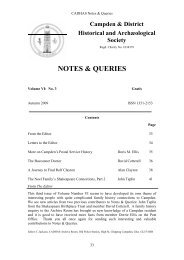notes & queries - Campden & District Historical and Archaeological ...
notes & queries - Campden & District Historical and Archaeological ...
notes & queries - Campden & District Historical and Archaeological ...
You also want an ePaper? Increase the reach of your titles
YUMPU automatically turns print PDFs into web optimized ePapers that Google loves.
CADHAS Notes & Queries<br />
the name of Samuell Smyth, presumably a curate or vicar at the time. In 1610 the<br />
curate of Brading, John Hooke, was licensed to act as curate for St Helens too. At one<br />
point the initials I.H. do appear in the register. He was the father of Robert Hooke the<br />
famous scientist.<br />
‘The key question of course is when the register went astray <strong>and</strong> why it should have<br />
ended up in Chipping <strong>Campden</strong>. It seems unlikely that we will ever know the answer<br />
to these questions. We know that the register was already missing in 1871, because<br />
the Hill’s Directory for that year says that the registers start in 1653, rather than 1593.<br />
‘On the other h<strong>and</strong> there are date calculations on the cover, which imply that the book<br />
was still in the custody of the church in 1759. The name John Scriven, on the cover is<br />
also that of a local family in the eighteenth century, although this does not prove that<br />
it was in the custody of the church at that date. It seems most likely that loose pages<br />
from the register were caught up in the papers of one of the curates or vicars who left<br />
the isl<strong>and</strong> between 1759 <strong>and</strong> a date some time in advance of 1871. There was a<br />
substantial rebuild of all but the chancel of the church in about 1830, <strong>and</strong> the church<br />
had moved site to a spot half a mile inl<strong>and</strong> in the first half of the eighteenth century.<br />
‘I do not think that we can assume that we are looking for a clergyman who went from<br />
St Helens to Chipping <strong>Campden</strong> either directly or via various other parishes, because<br />
once a document like this ends up in private papers, it could have moved in any one of<br />
a number of ways, with secular descendants of a clergyman moving into the area at a<br />
later date.’<br />
History of Court Barn<br />
Allan Warmington<br />
Readers will be aware that Court Barn in Church Street is at present being renovated<br />
by the Guild of H<strong>and</strong>icraft Trust. It has already been re-roofed, the stone floor taken<br />
up <strong>and</strong> relaid <strong>and</strong> much other conservation work done on it. By next year we hope it<br />
will have been transformed <strong>and</strong> while still retaining its present external appearance,<br />
will be the site of an exhibition, meeting room <strong>and</strong> study centre celebrating the<br />
craftsmen who have lived in <strong>Campden</strong> <strong>and</strong> surrounding towns <strong>and</strong> villages since the<br />
beginning of last century. There will be exhibits devoted to C.R.Ashbee <strong>and</strong> his Guild<br />
of H<strong>and</strong>icraft, to F.L.Griggs, Alec Miller, Paul Woodroffe, the Harts <strong>and</strong> Robert<br />
Welch; <strong>and</strong> to others, like Gordon Russell <strong>and</strong> Katharine Adams from Broadway <strong>and</strong><br />
the potters Michael Cardew <strong>and</strong> Ray Finch from Winchcombe.<br />
This article, however, is about the barn itself. It of course st<strong>and</strong>s on the edge of the<br />
grounds of Old <strong>Campden</strong> House <strong>and</strong> was built about 300 years ago. How ever did it<br />
come to intrude into the gardens of that magnificent house?<br />
After Sir Baptist Hicks’s new manor house was burned to the ground in 1645, its<br />
grounds <strong>and</strong> gardens <strong>and</strong> yards were gradually turned over to agricultural use. There<br />
is a deed dated 1691 by which the Hon. Susanna Noel, the mother of the 6 year-old<br />
3rd Earl of Gainsborough, leased it to Mary Rutter, a widow:<br />
“The Great Burnt Manor House with the brewhouse with the court on which it<br />
st<strong>and</strong>s, the burnt stable, the coach house the passage towards strappyard, the two<br />
porters lodges with the court in which they st<strong>and</strong>, the court on the north side of the<br />
great burnt house, the rose garden, the bleaching garden <strong>and</strong> garden house st<strong>and</strong>ing<br />
therein; the pool ground, the poultry yard, the garden joining to the parsonage<br />
21







